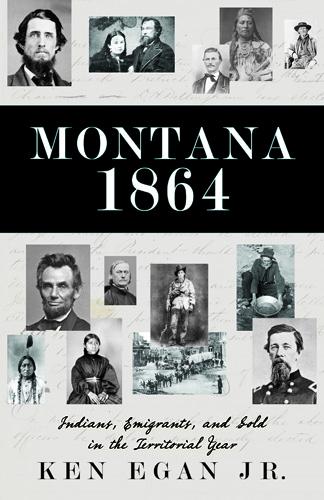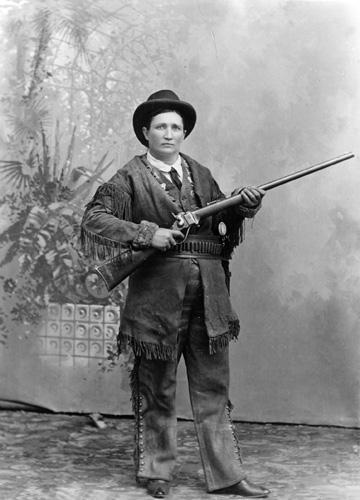Calamity Jane (excerpt from Montana 1864)

Distinctly Montana GAL
CALAMITY JANE
by Ken Egan Jr. * * * *In this book, writer and scholar Ken Egan captures the year of tremendous change when Montana became a Territory with a tapestry of stories about the characters—Indians, traders, trail blazers, miners, settlers, Vigilantes, and outlaws—whose lives were shaped by the gold rush and relentless push of white Americans into Indian lands. Ken Egan saw the Montana Centennial Train as a seven-year-old boy in 1964; this book is his Sesquicentennial Train. Montana 1864 is available from bookstores and from www.riverbendpublishing.com.

CALAMITY HAS ARRIVED IN MONTANA BY DECEMBER 31, 1864. A gambler, his prostitute wife, and their six children land in Nevada City after an arduous five-month journey from Iowa. When the pickings prove slim, the children, the oldest named Martha Jane, not to be confused with Mrs. Vail of Sun River Indian Farm, are forced to beg for food in Virginia City: “Three little girls, who state their names to be Canary, appeared at the door of Mr. Fergus, on Idaho street, soliciting charity,” reports the Montana Post. The children have turned to none other than James Fergus, he of the volcanic temper tantrum in August, who serves as a caretaker of the poor in the new town. Fortunately, “Mrs. Fergus, Mrs. Castner and Mrs. Moon kindly provided them with food and some clothing.” The children then return to Nevada City, “where they have existed for some time.” For the parents the reporter spares little sympathy, describing them as “inhuman brutes who have deserted their poor, unfortunate children,” showing a “most flagrant and wanton instance of unnatural conduct on the part of parents to their children.”
Just eight years old when we see her for the first time on the streets of the boom town, Calamity Jane has already established the pattern of life that will define her existence on this earth until her death in 1903. Her parents will be dead within three years, and she will need to fend for herself and her younger siblings through guile, gumption, and guts.

Martha was born to a farmer of thirty-one years and his boisterous, sometimes outlandish wife of sixteen in Princeton, Missouri. Her parents made an odd couple, at least as described by those who remembered their years in the Missouri farm country: Her father, Robert, seems to have been a relatively sober, unassuming man, quite ineffective at the basic task of making a living, while her mother, Charlotte, so much younger than her spouse, was fond of dressing in colorful clothing and expressing her opinions in equally vivid language. There is not much doubt which parent Martha favors. Her surname, Canary, will always seem ill-suited to the cocky, boisterous, loud-mouthed, profane, sentimental, dissembling, often drunk but never to be backed-down or cowed woman, unless one credits the story told by one of her acquaintances that she earned her surname by singing like a mule, the Rocky Mountain canary.
Her parents’ motives for making the risky trek to Montana in ’64 must remain a matter of speculation. Robert may have encountered legal difficulties in Missouri following his own father’s death (the son seems to have borrowed $600 against his father’s estate and was then unable to repay it). Martha will remember the journey as a chance to explore and hunt with boys and men in the wagon train. Once the Canarys arrived in Nevada City, hopes for wealth from mining plainly did not materialize, explaining how the self-righteous reporter for the Post could describe Robert as “a gambler in Nevada” and Charlotte as a “woman of the lowest grade.” The parents are not granted a dignified death. Charlotte will pass away in 1866 after working as a washer woman for miners, while Robert will depart this earth a year later in Salt Lake City. Martha is next glimpsed at Fort Bridger, built by the legendary figure who has taken such a prominent role in guiding emigrants to the new territory, in ’64. She will later tell a reporter,
Wal, we lived near a post, an’ them soldiers took care of me. I didn’t know nothing ’bout women ner how white folks lived; all I knowed was to rustle grub an’ steal rides behind the stage-coaches an’ camp with the Injuns.

Thrown onto her own wits and devices by the age of eleven, Martha masters the street smarts of a Huck Finn to survive. She has to be protean, shape-shifting, playful, and harsh so that no one can see her fully, determine her strengths and weaknesses, take advantage of her softness. She is fond of telling tall tales about herself, creating a kind of mythical identity celebrated by popular fiction and newspapers. She gains her initial fame through the overheated prose of a western dime novel, and she has the good sense to exploit her notoriety by selling photographs of herself and joining (briefly and awkwardly) Buffalo Bill’s Wild West Show. In reality, young Martha, often dressed as a scout or mule skinner, becomes a “camp follower” for military and railroad crews, a polite term for a prostitute. She later befriends famous men such as Wild Bill Hickok, shot down in Deadwood, though apparently they are never intimate. Much of her adulthood will consist of temporary partnerships, sometimes called marriages, and she gives birth to at least one child, a daughter named Jessie, though they do not see much of each other during Calamity’s relatively short term on this earth. Her life alternates between stabs at respectability and episodes of outrageous public drunkenness. Her childhood experience on that cold December day in Virginia City hints at the demons that possessed her.
The nickname “Calamity” sticks to her early in life, aided by the melodramatic popular media, yet it becomes both a curse and a blessing. It names her poor luck, her unfortunate tendency to find herself in rotten circumstances: orphan, prostitute, alcoholic drifter, and lonely mother. But “Calamity” also tells of her willingness to go toward trouble to help people in need, to assuage their pain, such as a young man dying from smallpox, a cowboy kicked by a horse, or a woman suffering from ailments of the womb and the heart. Martha will so completely defy Victorian convention that few will know how to classify her: Angel or whore, who could say for sure? Calamity Jane never wants to be reduced to a type. That’s one reason she remains a powerful presence in the region’s memory.